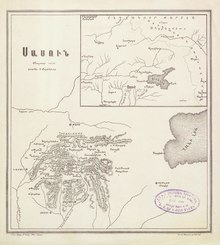
Sasun or Sassoun (Armenian: Սասուն), also known as Sanasun or Sanasunkʻ (Armenian: Սանասունք), was a region of historical Armenia. The region is now divided among the modern Turkish provinces of Muş, Bingöl, Bitlis, Siirt, Batman, and Diyarbakır, with the modern-day district of Sason in Batman Province encompassing only one part of historical Sasun.[1]
In antiquity, Sasun was one of the ten districts (gawaṛ) of the province of Aghdznikʻ (Arzanene) of the Kingdom of Armenia. Over time, Sasun came to denote a larger region than the original gawaṛ. In the 10th century, an independent Armenian principality based in Sasun and ruled by a branch of the Mamikonian dynasty emerged and existed until the 12th century. The region was conquered by the Ottoman Empire in the 16th century, and the district (kaza) of Sasun was made a part of different administrative divisions before finally being attached to the Mush sanjak of the Bitlis vilayet. Kurds settled in Sasun as early as the end of the 13th century, and an autonomous Kurdish emirate existed there until the 19th century.
The inhabitants of Sasun frequently enjoyed an autonomous or semi-independent status up to the modern era owing to the region's remoteness and inaccessibility, as well as to the armed resistance of its inhabitants. Sasun holds a significant place in Armenian culture, history and historical memory. The Sasun Armenians' reputation for courage and resistance to foreign rule is reflected in the Armenian national epic Daredevils of Sasun. In the late 19th and early 20th centuries, Sasun became a focal point of the Armenian fedayi movement and was the site of numerous clashes between Armenian militiamen, Kurdish irregulars and the Ottoman authorities. The Armenians of Sasun showed armed resistance during the Armenian genocide in 1915, during which most of them were killed. Some Armenians from Sasun managed to flee and settled in the territory of modern-day Armenia, while a small number remained in Sasun. Most of the Armenians that remained in Sasun after the genocide have since left the region, settling primarily in Istanbul, and the region is now populated primarily by Kurds.
- ^ McCarthy, Turan & Taşkıran 2014, p. 3.